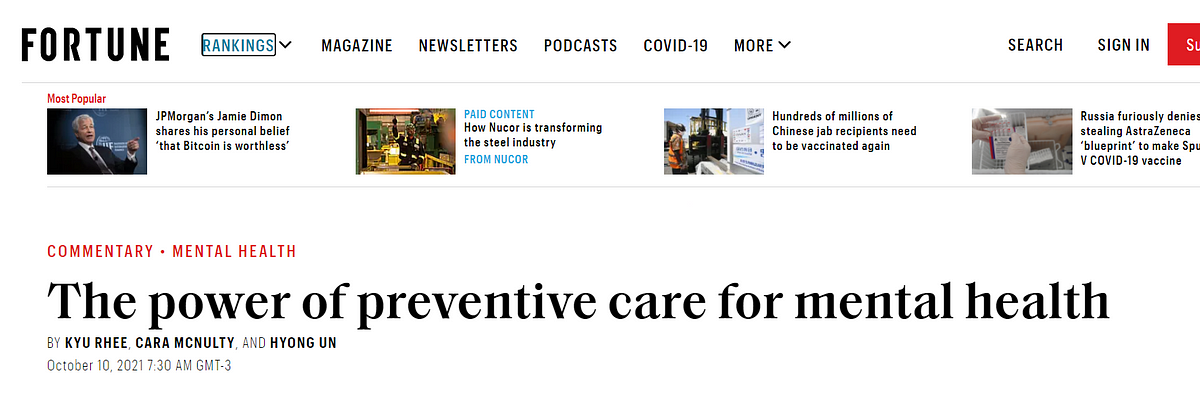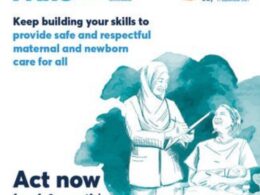The Health Strategist
Joaquim Cardoso, MSc.
October 12, 2021
This is a one page summary of our analysis of the article published at “Fortune” with the title on the 2nd part of this post, about the CVS — Aetna case in the USA. Our analysis is based on the description of the authors, and we did not conduct a performance assessment of the programs they describe.
What is the problem?
- People constantly face stressors, events and diagnoses that impact our overall well-being, a reality that the COVID-19 pandemic has further revealed, making it critical that our approach to preventing and caring for these mental health issues meets these needs.
What is the approach?
- Aetna, a CVS Health company, understands that every individual sits along a continuum of mental and emotional health needs — from facing moments of anxiety or stress to longer-term clinical diagnoses, and everything in between.
- To truly make mental health care a reality for all, we must meet people where they are along this continuum through a three-pronged approach to prevention.
- Preventive care is powerful, and we must not forget the influence it has on all aspects of our health, including our mental well-being.
What is the strategy?
- CVS — Aetna has developed 3 phases program for Mental Health:
(1) Primary prevention: Addressing root causes;
(2) Secondary prevention: Early signs and treatment options;
(3) Tertiary prevention: Intervening with treatment
(1) Primary prevention: Addressing root causes
- … a staggering 65% of Americans ages 18–34 have had concerns about their own mental health or that of household members, family or friends since the pandemic outbreak began.
- Addressing loneliness is one way we can lower feelings of depression and anxiety before they even start. Two ways CVS Aetna does that is by:
(1) Bringing together communities with similar experiences;
(2) Employee Assistance Programs (EAPs)
- Employee Assistance Programs (EAPs) are also valuable modes of preventing escalated mental health concerns, as they provide 24/7 life assistance across a wide range of issues that can lower risks of feeling overwhelmed, anxious or depressed. EAPs see: (a) a 24% improvement in life satisfaction and; (b) a 10% reduction in workplace distress among their workers.
(2) Secondary prevention: Early signs and treatment options
- One in eight emergency department visits are related to mental health or substance abuse, demonstrating missed opportunities to identify early signs of mental health concerns before they rise to an emergency.
- By proactively surrounding individuals with mental health resources, in their everyday lives and when interacting with the health care system, we can effectively spot early signs of mental health needs and and direct people on the right path to well-being.
- For the health care industry, one of the most effective ways we can identify mental health needs early is through patient data analysis.
- Providers also play a critical role in early detection of these needs, especially with 76% reporting a high or moderate proportion of their patients face mental health issues.
- Arming providers with instructions, tools and resources to identify and direct those facing mental health challenges to the right care … can lead to meaningful change toward preventing further mental health concerns.
- An effective approach to early detection combines all of these measures — proactive consumer outreach, provider training and embedding resources in local communities and other care settings — to improve mental health.
(3) Tertiary prevention: Intervening with treatment
- Mental health care is accessible in more ways than we’ve ever seen before — from seeing a therapist in person, to connecting virtually or over the phone to text, we are continuously evolving modes of mental health intervention.
- Telemedicine has proven to be particularly effective for mental health care as it allows for greater convenience in connecting with a provider, and it can be a good option for those who are apprehensive about receiving this kind of care in person.
- Studies have also shown that integrating telebehavioral health into primary care and increasing access to telepsychiatry has led to improvements in patients’ mental health.
- The expansion of home delivery of mental health medications to ensure people adhere to medication guidance to recover and prevent future risks is another positive step in this regard.
Final observation about C-Roles in Mental Health:
- We also noticed from the article that three people from CVS — Aetna sign the article. It´s worth mentioning their positions in the organizations: (a) Senior vice president and Aetna chief medical officer; (b) President of Aetna Behavioral Health; (c ) Chief psychiatric officer at Aetna.
- The point we make here is that in addition to the Chief Medical Officer (CMO) position, the organization also has two another positions for Behavioral Health President and Chief Psychiatric Officer.
- This may be roles that other organizations may want to investigate to add in their organization chart, in case they don´t have it yet.
ORIGINAL PUBLICATION
_______________________________________________________________

The power of preventive care for mental health
Fortune
BY KYU RHEE , CARA MCNULTY , AND HYONG UN
October 10, 2021
Image: “Every individual sits along a continuum of mental and emotional health needs — from facing moments of anxiety or stress to longer-term clinical diagnoses, and everything in between,” the authors write.GETTY IMAGES
It’s no secret that conversations around mental health are on the rise. Though it took a while to get here, we are proud to see more discussions take place on a topic that, for too long, has been highly stigmatized.
Observances such as the World Health Organization’s World Mental Health Day today help elevate this much needed dialogue.
However, while these days are important, they also remind us to treat every day as a mental health day.
People constantly face stressors, events and diagnoses that impact our overall well-being, a reality that the COVID-19 pandemic has further revealed, making it critical that our approach to preventing and caring for these mental health issues meets these needs.
… we are also reminded … to treat every day as a mental health day.
At Aetna, a CVS Health company, we understand that every individual sits along a continuum of mental and emotional health needs — from facing moments of anxiety or stress to longer-term clinical diagnoses, and everything in between. To truly make mental health care a reality for all, we must meet people where they are along this continuum through a three-pronged approach to prevention.
Table of Contents (TOC)
- Primary prevention: Addressing root causes
- Secondary prevention: Early signs and treatment options
- Tertiary prevention: Intervening with treatment
Primary prevention: Addressing root causes
The COVID-19 pandemic has put a new lens on how we think about mental well-being, as people have faced increased levels of loneliness, routine disruption and anxiety.
In fact, Aetna and Morning Consult data found that a staggering 65% of Americans ages 18–34 have had concerns about their own mental health or that of household members, family or friends since the pandemic outbreak began.
Yet, the study also found that nearly one in four of the same respondents are not confident in finding help to address these concerns.
… a staggering 65% of Americans ages 18–34 have had concerns about their own mental health or … close relationships … since the pandemic began.
Addressing loneliness is one way we can lower feelings of depression and anxiety before they even start.
Bringing together communities with similar experiences
Bringing together communities that have faced similar experiences, such as through forums like Aetna-hosted Here4U sessions, allows people to feel that they are not alone in the struggles they face.
The Here4U sessions held recently for women, African American women, moms, and moms of children with special needs have demonstrated a positive impact on attendees’ mental health, with participants reporting a 31% improvement in feeling connected to their peers.
Addressing loneliness is one way we can lower feelings of depression and anxiety before they even start.
Bringing together communities that have faced similar experiences …allows people to feel that they are not alone in the struggles they face.
Employee Assistance Programs (EAPs)
Employee Assistance Programs (EAPs) are also valuable modes of preventing escalated mental health concerns, as they provide 24/7 life assistance across a wide range of issues that can lower risks of feeling overwhelmed, anxious or depressed.
In fact, one study found that companies with EAPs see
- a 24% improvement in life satisfaction and
- a 10% reduction in workplace distress among their workers.
Employee Assistance Programs (EAPs) are also valuable modes of preventing escalated mental health concerns
But we need to better inform people that EAPs are more than a workplace productivity tool.
Aetna’s Resources for Living, which provides EAP services, is one example of a resource that supports those facing stress and anxiety, family conflict, legal and financial issues, grief and loss and even loneliness among our Medicare members.
Secondary prevention: Early signs and treatment options
One in eight emergency department visits are related to mental health or substance abuse, demonstrating missed opportunities to identify early signs of mental health concerns before they rise to an emergency.
By proactively surrounding individuals with mental health resources, in their everyday lives and when interacting with the health care system, we can effectively spot early signs of mental health needs and direct people on the right path to well-being.
One in eight emergency department visits are related to mental health or substance abuse, demonstrating missed opportunities to identify early signs of mental health concerns before they rise to an emergency.
For the health care industry, one of the most effective ways we can identify mental health needs early is through patient data analysis.
As part of Next Best Actions, our data scientists use consumer data on past behaviors and preferences to guide Aetna members toward decisions or services that will achieve their best total well-being.
For example, we use data from medical claims to identify members with chronic conditions who are likely at higher risk for having a mental health issue and proactively reach out to them with resources for support.
For the health care industry, one of the most effective ways we can identify mental health needs early is through patient data analysis.
Providers also play a critical role in early detection of these needs, especially with 76% reporting a high or moderate proportion of their patients face mental health issues.
Arming providers with instructions, tools and resources to identify and direct those facing mental health challenges to the right care, such as through Aetna’s work with PsychHub, can lead to meaningful change toward preventing further mental health concerns.
Providers also play a critical role in early detection of these needs, especially with 76% reporting a high or moderate proportion of their patients face mental health issues. We can arm providers with instructions, tools and resources.
To support spotting mental health needs in other health care settings, CVS Health provides mental health screenings during MinuteClinic appointments, and licensed clinical social workers in select HealthHUB locations provide virtual or in-person mental health assessments and treatment planning.
An effective approach to early detection combines all of these measures — proactive consumer outreach, provider training and embedding resources in local communities and other care settings — to improve mental health.
An effective approach to early detection combines all of these measures — proactive consumer outreach, provider training and embedding resources in local communities and other care settings — to improve mental health.
Tertiary prevention: Intervening with treatment
While intervention is more focused on the action taken when a clinical issue has already presented itself, it is an equally important aspect of preventing mental health needs from worsening.
Mental health care is accessible in more ways than we’ve ever seen before — from seeing a therapist in person, to connecting virtually or over the phone to text, we are continuously evolving modes of mental health intervention.
Mental health care is accessible in more ways than we’ve ever seen before — from seeing a therapist in person, to connecting virtually or over the phone to text, we are continuously evolving modes of mental health intervention.
Among Aetna’s Commercial members, 60% of outpatient mental health visits were done via telemedicine in 2020, up from just one percent in 2019.
That higher figure is holding steady through this year, which is a positive development!
Telemedicine has proven to be particularly effective for mental health care as it allows for greater convenience in connecting with a provider, and it can be a good option for those who are apprehensive about receiving this kind of care in person.
Studies have also shown that integrating telebehavioral health into primary care and increasing access to telepsychiatry has led to improvements in patients’ mental health.
Telemedicine has proven to be particularly effective for mental health care as it allows for greater convenience …and it can be a good option for those who are apprehensive about receiving this kind of care in person.
… integrating telebehavioral health into primary care and increasing access to telepsychiatry has led to improvements in patients’ mental health.
We also know that individuals increasingly want to receive care conveniently in their communities, and in a way that is connected to their overall health care plan and lifestyle — connecting their physical and mental health care to where they are shopping for other well-being products and picking up their prescriptions.
The expansion of home delivery of mental health medications to ensure people adhere to medication guidance to recover and prevent future risks is another positive step in this regard.
The expansion of home delivery of mental health medications to ensure people adhere to medication guidance to recover and prevent future risks is another positive step in this regard.
Preventive care is powerful, and we must not forget the influence it has on all aspects of our health, including our mental well-being.
As the focus on the mental health of ourselves, loved ones and communities continues to rise, Aetna and CVS Health remain committed to ensuring that no one is alone on this journey and supporting our partner providers and companies across the country to do the same.
Through this work, we can make progress toward improving mental health for our communities, workplaces and families.
About the authors
- Kyu Rhee, M.D. is senior vice president and Aetna chief medical officer at CVS Health;
- Cara McNulty, is the president of Aetna Behavioral Health;
- Hyong Un, M.D. is chief psychiatric officer at Aetna












